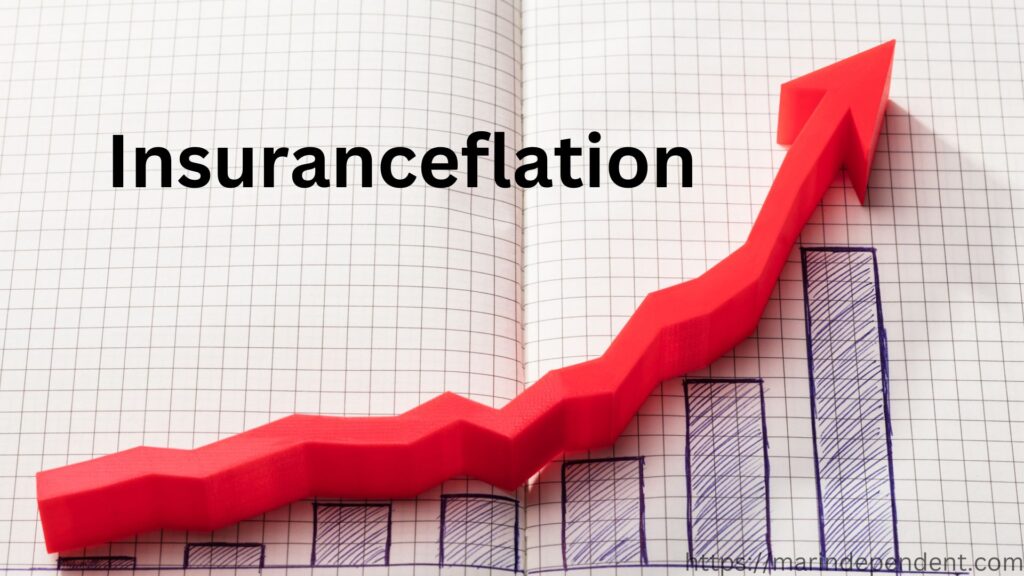March 11, 2023
The Insuranceflation Story
California is undergoing a tremendous increase in insurance costs.
We call this rising cost of insurance – insuranceflation.
The causes of insuranceflation. Some obvious, some not.
What is Insuranceflation?
Simply put insuranceflation is the increasing cost of insurance. Buy a house and watch the cost to insure it go up each and every year – that maybe insuranceflation. In California this process seemed to be more unique to home and liability insurance. However lately this seems to be spreading to other lines of insurance in this great state. Up Next Auto Insuranceflation.
Definitions of Standard Inflation:
The International Monetary Fund defines inflation as “the rate of increase in prices over a given period of time.” It adds that it “is typically a broad measure….But it can also be more narrowly calculated…” The IMF points out that “inflation represents how much more expensive the relevant set of goods and/or services has become over a certain period, most commonly a year.”
With Insuranceflation those goods are the insurance policies themselves and the protection they provide.
Britanica has a more broad definition: “in economics, collective increases in the supply of money, in money incomes, or in prices. Inflation is generally thought of as an inordinate rise in the general level of prices.” The inordinate rise in….prices is perhaps one of the more simple and easy to understsand definitions of this type of economic action.
What we are speaking about in this short article is the the Inflation of Insurance.

Our Definition of Insuranceflation:
We view insuranceflation as “The inordinate rise of insurance prremiums.” Insuranceflation might also be described as Inflation of Insurance.
Insuranceflation: The inordinate rise of insurance premiums.
Insuranceflation – Two Considerations:
When viewing the rising cost of insurance, it can be pretty confusing. Is it the actual cost of the insurance or the value of thing that is being insured? In liability insurance – which is often listed in millions of dollars of cover – that can be more clear. However with property insurance it can be far less clear since the property value can change over time. And many property insurance policies do not simply state the amount of property coverage provided. Think of a typical auto insurance policy here.
Property Insurance Valuation Methods:
In a very general [yet wholly incomplete] way of thinking of it – property insurance can be written in a few different valuation methods: Actual Cash Value, Replacement Value, and Agreed Value. [Please do be aware that it is technically far more complicated than this- but for the purposes of this discussion let us stick with these three main categories.]
Actual Cash Value is the depreciated value of an item. You buy a T Shirt for $20. You wear and lauder it 50 times, what is it worth if it is destroyed in a fire? I dont know -but it is not worth $20…Perhaps $3.
Replacement Value is the cost to replace that item. If the T Shirt is destroyed in a fire, that $3 in actual cash value valuation is not going to help you much. What you really want is the money to go buy a new T Shirt. That new T Shirt may cost more than you originally spent, perhaps $22 now.
In an example with Agreed Value – sometimes called Stated Value – we may both agree to insure that T Shirt at a specific value. Perhaps it was signed by Madonna and the “appraised” value of it is now $200. So after we get an appraisal and show it the insurer – it is listed on the insurance policy as having an agreed value of $200.
Those are the three building block valuation types with most personal property insurance. Those are not all. In the Replacement Value valuation method the cost difference between $20 of the original purchase price and $22 at the new purchase price is what we are discussing here. That increase of $2 is one portion of the problem with insurance inflation. It is the direct property cost inflation. This consideration is really not specific to insurance – its specific to all property items. Stuff costs more, so the insurance policy replacement valuation has a higher coverage amount. That higher coverage amount by itself raises the cost of the insurance policy. We are no longer insuring a $20 T Shirt, but a $22 T Shirt. A typical American household is filled with items that are not disssimilar from this $22 T Shirt. The TV, the Couch, that Lamp – all victim of direct inflation. And assuming you purchased your homeowners policy from an agent that got you a personal property replacement valuation form you should be OK.
However that is only part of the insurance inflation or insuranceflation equation.
The Other Side of the Insuranceflation:
At this point, we have reviewed that the underlying value of a given item changes the insurance premium. But what about the pure insurance metric[s] that is used to derive insurance costs.
At this point it is fairly obvious that the cost to insure homes in California, due to wildfire is higher. Since there are more wildfires and more destruction the insurers are incurring more losses. When the insurers incur more losses they need to charge more for insurance. This example seems obvious to Americans. But the same is true for Automobiles. Autos are covered for wildfire as well if physical coverage is included. When a bad wildfire rips through a neighberhood it destroys the cars on the streets and garages.
Reinsurance – a Key Driver of Insuranceflation
One key financial number that does directly increase insurance costs is ReInsurance. Reinsurance is a form of insurance that insurers have. If an insurance company uses this product and it becomes more expensive. The NAIC explains that with reinsurance “the insurance company—the cedent—transfers risk to the reinsurance company, and the latter assumes all or part of one or more insurance policies issued by the cedent. ” These policies are fairly common in the P&C world.
The Wall Street Journal notes that reinsurers are planning on “boost[ing] rates by 10% to 30%.” They ” are reacting to five years of outsize catastrophe losses and growing worries that climate change is intensifying the risks from storms and wildfires, among other concerns.” These are real costs causing insuranceflation.
The Insurance Journal reported in January of 2023 that the “average global rate increases recorded at the renewals were 37%-plus for global property catastrophe” in regards to reinsurance premiums. “Gallagher Re described the reinsurance renewal season process as tense, late, complex and, in many cases, frustrating.” As of late the reinsurnace premiums have been one of the biggest challenges for US property insurers. However it should be noted that reinsurance prices are not exclusive to risk inside the United States and the market for this product is global.

Insuranceflation – So Many Factors – So Little Time:
Rising insurance costs, or insuranceflation has lots of causes. So seemingly tied to direct inflation – others not.
According to the US Department of Transportation: “While Americans drove less in 2020 due to the pandemic, NHTSA’s early estimates show that an estimated 38,680 people died in motor vehicle traffic crashes—the largest projected number of fatalities since 2007.” Increased traffic deaths come with higher insurance payouts.
Property Valuations, Traffic Accidents and Reinsurance though are not the only factors driving insurance premiums higher. There are some super obvious ones, and then there are reasons that seem so small and insignficant, but they are not. Liberty Mutual lists “the chip shortage” as being a factor “contributing to increased costs…” Source.
Social Inflation – over the years has been a key driver of increased insurance costs. The III loosely defines Social Inflation as ” how insurers’ claims costs can rise above general economic inflation, and it also includes the shifts in societal preferences over who is best placed to absorb risk.” A Key factor that is most often talked about is “increase in the number of outsized jury awards” The III: Social inflation: hard to measure, important to understand. Think of the landmark case of the individual procuring coffee from a fast food restaraunt and spilling it in her own lap.
Bankrate reports that the Labor Shortage “means one thing for car insurers: higher rates.” Most people have experienced this to some extent – you wish to hire someone but there are so few people available that you lose any negociating ability you once may have had. WIth only one autobody shop open in town, what can you do?
In our opinion, the regulatory environment, as well meaning as it is, could be one of the causes [indirectly] of insurance inflation. Without getting into too much detail here – Insurance Companies need to make enough to pay all of their claims plus all of their expenses, and typically turn a small profit. The Loss Ratios are a matter of public record. Their insurance rates or premiums typically to some extent have to be approved by a state regulator. However some state regulators seem to be doing their best to prevent reasonable rate increases from going through. The net result is insurers refusing to take on new business. Less insurers in the eligible pool only increases overall premiums for consumers, in our opinion.
Insurance Fraud is a favorite topic of those same regulators and one that they do have a hand in preventing. Insurance Fraud too is a key driver with insuranceflation. More Fraud = Higher Costs. Friss reports that “insurance professionals suspected 18% of claims might contain fraud. In 2022, however, that suspicion rose to 20%.” That might not be exactly true – but Insurance Fraud is certainly not diminishing.
The California DOI states on their own website that: “it is estimated that workers’ compensation fraud costs the state between $1 billion to $3 billion per year.” Workers Comp is generally considered to be the worst fraud area in the insurance landscape. But other types of fraud exist as well along all lines.
There are literally hundreds of other drivers for the higher costs of insurance. One though that is increasingly being mentioned is Climate Change. In our opinion Climate Change hits insurers in two distinct ways.
First, with more wildfires, floods, etc – there is just more claims activities. This seems somewhat obvious. The second way though, is far less obvious. With increased environmental regulatory rules come higher costs. A very simple example are batteries. Sure batteries are great, but when you are done with them – you just cant throw them away – they need to recycled. In order to fight climate change, California, among other states, has encouraged or required that more and more internal combustion engines be replaced by battery powered engines. Climate Change inflation or Climateflation is an important consideration here.
Those are just some of the factors causing insuranceflation, or the the inordinate rise of insurance prices. Certainly there are many others. Insuranceflation is a real problem in California and beyond.
The Insuranceflation Story – A Summary:
Insuranceflation seems to be here to stay – at least in the decade of the 2020’s. Numerous factors are increasing insurance premiums: Fraud, Climate Change, Inflation, and Social Inflation are just some of them. Many factors are obvious, but some are not. Only time will tell the permanence of insuranceflation in California and beyond.








